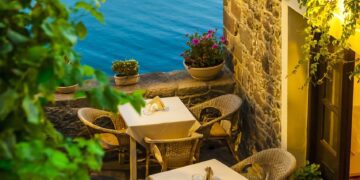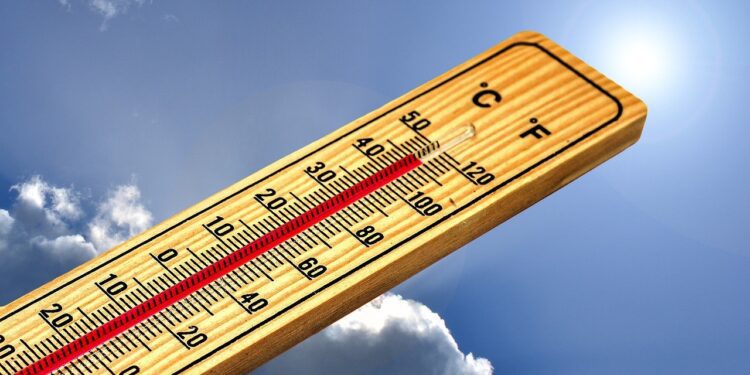Spain is no stranger to sizzling summers, but 2025 is tracking well above the long-term heat average. AEMET thermometers already hit 42 °C in Mérida and Écija this week, with forecasters warning peaks of 43 °C across the south-west and Ebro basin in the next few days. Nights are staying a sweltering 25 – 27 °C, denying the land its usual cooldown.
At the national level, orange and occasional red “MeteoAlarm” warnings now appear almost daily on AEMET’s hazard map, signalling a persistent, multi-day extreme-heat episode.
Climate scientists blame a stubborn subtropical ridge, drier soils after a low-rain spring, and the compounding effect of global warming. The result: a Spanish summer more reminiscent of the Sahara than the Med.
2. Where The Mercury Tops 43 °C
While every region feels the heat, travellers should plan extra-carefully if visiting these hotspots:
| Region | Typical June–July highs 2025 | Why it bakes |
| Andalusia (Seville, Córdoba, Jaén) | 41 – 43 °C | Low-lying Guadalquivir valley traps hot air |
| Extremadura (Mérida, Badajoz) | 40 – 42 °C | Continental interior, scant sea breeze |
| Castile-La Mancha & Madrid | 38 – 41 °C | High-sun plateau, urban heat island |
| Murcia & Valencia interior | 39 – 41 °C | Dry winds funnel down from La Mancha |
| Aragón’s Ebro valley (Zaragoza) | 39 – 42 °C | Foehn-like “Cierzo” wind accelerates heating |
Euro Weekly News flagged similar figures when temperatures bounced back above 40 °C in early June.
3. Plan Before You Fly
- Book air-conditioned stays (only 65 % of Spanish rentals guarantee full AC).
- Build flexibility into itineraries: swap midday sightseeing for sunrise photos or evening tapas crawls.
- Upgrade travel insurance – make sure heat- or wildfire-related cancellations are covered (see FCDO guidance)
- Register real-time alerts: download AEMET’s app or MeteoAlarm Europe and enable push notifications.
4. Adopt a Heat-Smart Daily Rhythm
| Time | Do | Why |
| 06:00 – 11:00 | Outdoor exploration, hikes, markets | Air and pavement still below 30 °C |
| 11:00 – 18:00 | Siesta, museums, shaded cafés | UV index peaks; asphalt can reach 60 °C |
| 18:00 – 02:00 | Evening wander, late dinners, fiestas | The Spanish lifestyle is built around cooler nights |
5. Hydration & Nutrition Hacks
- Drink ½ litre of water every hour, even when not thirsty.
- Alternate with low-sugar isotonic drinks or cold gazpacho for salt replacement.
- Limit midday alcohol; swap sangría for “tinto de verano” with extra soda.
- Snack on salted almonds, olives, and juicy melón to balance electrolytes.
WHO Europe’s heat-health guidance stresses regular fluid intake and salt replacement as the single most effective defence against heat stress.
6. Shield Skin & Eyes
- SPF 50+ broad-spectrum sunscreen reapplied every two hours.
- UPF-rated long-sleeved linen or tech-cool fabrics.
- Wrap-around UV400 sunniest and a 7-cm-brim hat.
- Carry a mini-spray mister; Spanish supermarkets sell 100 ml formats that pass airport security.
7. Keep You Cool on the Move
- Car travel: park in shade, crack windows, use reflective sunshades. Temperatures inside a closed car can exceed 60 °C in 15 minutes.
- Train & coach: RENFE long-distance services are air-conditioned, but short regional lines may cut AC when parked – wait on shaded platforms.
- Urban wandering: duck into free “refugios climáticos” (libraries, malls, town-hall chill rooms) popping up across major cities.
8. Recognise Heat Danger Signs
| Heat exhaustion (call 112 if no improvement) | Heat stroke (medical emergency – call 112 immediately) |
| Dizziness, nausea, heavy sweating, fast pulse | Confusion, body temp ≥ 40 °C, dry skin, seizures |
| Cool, pale, clammy skin | Possible loss of consciousness |
| Headache, muscle cramps | Cessation of sweating |
Move the person to shade, cool the body rapidly (wet towels, fan, ice packs), and stay with them until help arrives.
9. Stay wildfire-aware
The 2025 wildfire outlook is “above average” according to Spanish meteorologists, with dry vegetation primed to ignite. The UK FCDO also reminds visitors that blazes occur regularly on the mainland and islands.
- Obey local fire-risk signage and bans on outdoor grilling.
- Keep Google Maps wildfire layer active and pack an FFP2 mask for smoky air.
- If authorities ask you to evacuate, do so immediately and follow the marked ruta de evacuación signs.
10. Tech & alert toolkit
- AEMET app – geolocated alerts in English & Spanish.
- Protección Civil Telegram bot – push notifications by province.
- 112 – Europe-wide emergency number (works without Spanish SIM).
Set phones to extreme battery-saver and store a lightweight 10 000 mAh power bank; blackouts sometimes accompany heat-driven grid strain.
11. Sustainable (and Cultural) Cooling
Spain’s cities are planting shade trees, rolling out reflective paint on pavements, and reviving Moorish-era courtyards to fight heat. Join locals in:
- Evening paseo – the 9 p.m. stroll along breezy riverfronts.
- Indoor tapas bursts – hopping bar-to-bar keeps exposure brief.
- Choosing rail over domestic flights, cutting your carbon footprint and AC reliance.
12. Quick Grab Packing List
- Cooling towel or neck gaiter
- Refillable 750 ml metal water bottle
- Electrolyte tablets
- Mini SPF stick for lips/nose
- Packable UPF parasol or umbrella
- FFP2 masks (for wildfire smoke)
- Lightweight long trousers (respect dress codes & sun-protect)
- Power bank & Type-C cable
13. Final Thoughts – Adventure with Respect
Yes, 43 °C sounds forbidding, but with a heat-adapted schedule, proper hydration, and alertness to official warnings, you can still relish flamenco nights in Seville, citrus-scented lanes in Córdoba, or a moonlit swim off Menorca. Spain’s love of late-night life is a built-in survival tactic – embrace it, and you’ll thrive.
Pack smart, travel responsibly, and let the Vaycay Couple guide you to memories that outshine the mercury. ¡Buen viaje!














